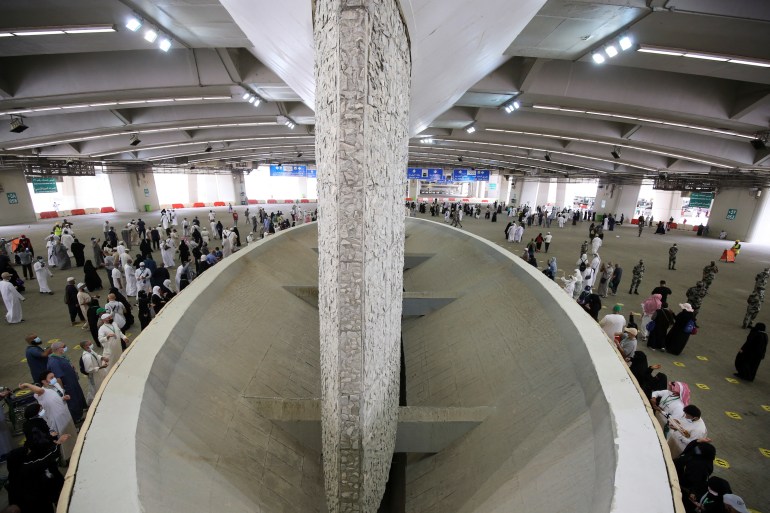More than a thousand tons of Jamarat are thrown annually during the Hajj season, and in the absence of a mechanism to transport these Jamarat periodically, they would have accumulated to form one of the mountains.
During the Hajj season, pilgrims throw Jamarat, over the three days of Tashreeq, starting from the Lesser, Middle and then Major Jamarat, and the pilgrim takes the Jamarat from Mina or Muzdalifah, a group of small-sized pebbles.
A group of scholars stated that the wisdom behind throwing the Jamarat is to insult and humiliate Satan and show his dissent, and to follow the Sunnah of the Holy Prophet (may Allah's peace and blessings be upon him) when he said, "Take away your rituals from me."
But where do these embers go after the pilgrims throw them? The answer is that it goes through several stages after the pilgrim throws it, where it descends at the bottom and moves on a path to collect it, and it is examined and the embers are selected from others.
At the bottom of the Jamarat Bridge lies the secret of collection, where the gravel mechanism systems are lifted with huge belts that pull the existing pebbles, after collecting them in the three Jamarat basin, and each basin contains two systems to raise everything thrown at the bottom of the bridge at different speeds, in addition to doors that are controlled automatically in opening, closing and determining the path of gravel and their quantities, and the system is characterized by sorting sensors to filter and isolate what is thrown from non-gravel.
The amount of embers disposed of annually is estimated at about a thousand tons (Reuters)
Automated System
The automated lifting system has helped speed up the storage of gravel in the basement of the bridge structures, and the system works - through electronic gates on the floors of the Jamarat Bridge - to transfer them to the compressor carriages waiting deep inside the facility located at the bottom of the bridge.
The gravel is then disposed of – as waste – in the approved targets, and the quantities disposed of according to official statistics are estimated at about one thousand tons per year.
The Jamarat facility is one of the most prominent projects in Mina, with a total cost of more than 4.2 billion Saudi riyals (USD 3.75 riyals), a capacity of 300,950 pilgrims per hour and a length of 80 meters and a width of 12 meters, and the foundations of the facility are designed to be able to withstand 5 floors, and <> million pilgrims in the future if the need arises.
The project consists of 5 floors, each 12 meters high, and has all the support services for the comfort of pilgrims, including a ground tunnel to transport pilgrims so that it separates the movement of vehicles from pedestrians.
The project includes 11 entrances to the Jamarat and 12 exits in the four directions, in addition to providing it with an emergency helipad, ground tunnels, and an advanced cooling system that works with the desert air conditioning system that pumps a kind of spray on pilgrims and the areas surrounding the Jamarat, which contributes to reducing the temperature to about 29 degrees.
The project is one of the most prominent projects that Saudi Arabia was keen to implement to provide security and safety for pilgrims, eliminate the dangers that used to occur in the Jamarat area, and avoid all problems caused by the severe crowding that used to occur when throwing the Jamarat.
Jamarat Bridge is the most continuously developed emotion facility (Reuters)
Continuous development
Since its construction in 1974, the Jamarat Bridge has witnessed a number of development works, expanding it to a width of 40 meters, with two entrances from the eastern and western sides, and two slopes next to the Jamrat al-Aqaba from the upper floor from the northern and southern sides, in order to disembark pilgrims. Interest in the development of the bridge continued, and in 1978 reinforced concrete ramps (sights and houses) were implemented to the second level of the Jamarat on both sides of the bridge opposite the Minor Jamarat.
After the pilgrims throw into the embers, where do those stones go and how are they disposed of?
Many of you, like me, have asked yourself this question.
Yesterday, I visited the Jamarat building and had a scoop for the answer to that question, and for the first time it was filmed.
I also learned that the Jamarat building, with its six floors, is the largest building in the world, built of concrete. pic.twitter.com/4MZlAA2hgw
— Faisal Al-Abdulkarim (@f_alabdulkarim) August 23, 2018
In 1982, the bridge witnessed an expansion by increasing its width to 20 meters and a length of 120 meters from the northern side loyal to the Minor Jamra, in addition to another expansion in 1987 by increasing its width to 80 meters and a length of 520 meters, and the expansion of the ascent ramp to 40 meters by a length of 300 meters, and the construction of 5 service towers on both sides of the bridge and the implementation of signboards, lighting and ventilation, with a total area of 57,600 square meters.
The Jamarat Bridge entered a new phase of organization and development, where in 1995 a modification process was carried out in different stages, in a way that combined the view of the bridge and the representation of the movement of pilgrims on it, followed by similar modifications in 2005, including the structure of the bridge, modifying the shape of the basins from circular to oval, modifying the signs, establishing new emergency exits at Jamrat al-Aqaba and installing indicative signs that include information to educate pilgrims and warn them in the event of crowding.

